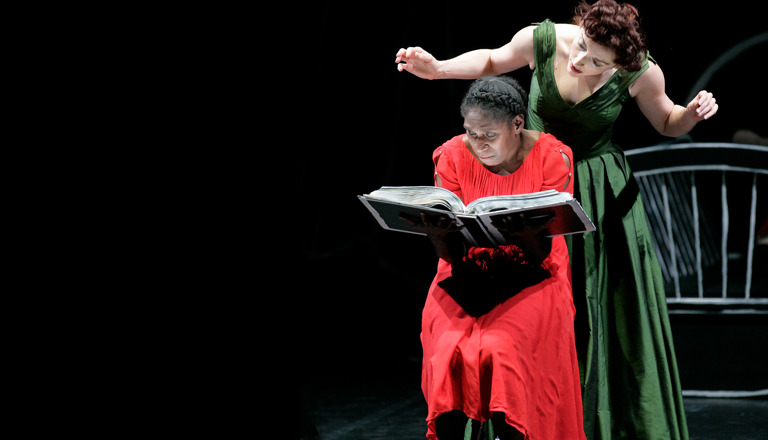Mathinna (2008)
Bringing the Story to the Stage: The Creative Process
RESEARCH AND PREPARATION
The creating of Bangarra’s production of Mathinna began with extensive research of historical record, as well as various literary and visual interpretations. Most importantly, there were close consultations with several Aboriginal Tasmanian community elders.
There is not a great deal of factual primary source material about Mathinna or her tragic story. There are some references to her in the diaries of George Robinson and Jane Franklin, as well as an article in the Hobart Mercury of 11 February 1870. [1] However, her story has survived and has clearly provided inspiration for writers and theatre makers. The occasion of her portrait being painted by the convict artist Thomas Bock is significant and has provided a face to Mathinna’s story.
DANCE PRACTICE
Mathinna was created by the choreographer, in close collaboration with the dancers, the composer of the music, and the costumes, set and lighting designers – the creative team. This enables the dance to reflect the overall focus of the choreographer’s intent.
The choreographer, the rehearsal director and the dancers work together in the dance studio for many hours a day over several weeks to create the choreographic elements for production. Together they invent movements that are inspired by the story, as they develop their artistic interpretation of its meaning.
They experiment with each movement, practicing them over and over again. They slowly build the movements into phrases and arrange these phrases into sequences of movements.
DANCE SKILLS
Using their dance technique and performance skills they work to blend the movements and make them articulate and technically achievable, eventually settling on a final version of the choreography.
The rehearsal director is present throughout this process in order to rehearse the dance, so that the key qualities and details of the choreography as set by the choreographer are retained, as the artists move on to create other sections of the work. As the work moves closer to its premiere date, the rehearsal director will work with the dancers for many hours to make sure they can perform the dance consistently at the highest standard possible. It is during this period in the process, the technical elements of the designers – costumes, sets, and lighting – start to be incorporated.
DANCE PRODUCTION PROCESSES
A couple of days before the premiere, the dancers, rehearsal director, creative team and production crew move from the Bangarra dance studios to the theatre where there will be many hours spent rigging the set, positioning and programming the lighting, and making necessary adjustments to the choreography to fit the space of the stage. This is called the ‘bump in’ and the production crew are largely responsible for coordinating this stage of the process.
There is often a media call on the day of the premiere where photographers take pictures of the dancers in dress rehearsal, and interviews with the creative team are conducted. On premiere night reviewers will attend to write about the work for their respective newspapers, websites and blogs. These reviews are usually published as soon as possible after the premiere.
During the lengthy process of creating a new Bangarra production, ideas will change and surprising shifts in the original plans will occur. This is the normal nature of the creative process, and probably one of the most exciting things about making a new work. However, the things that do not change are the traditional stories and original cultural elements, which always remain respected and intact. As the dance is performed over time, the story is passed from one dancer’s body to another as different dancers are taught the choreography.

